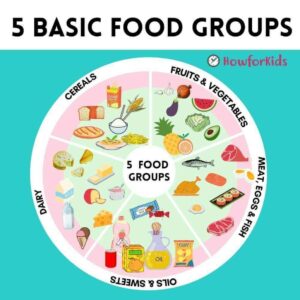What is Digestive System?
The digestive system is a set of organs located one after the other in charge of the digestion process. Food is the fuel our body needs to live and function properly. In order to be absorbed and used, food must be “digested”, that is, it must be broken down into small pieces. Each portion of this tube has a different shape and function. It starts at the mouth and ends at the anus. We are going to explain The Digestive System Parts and Functions for children.
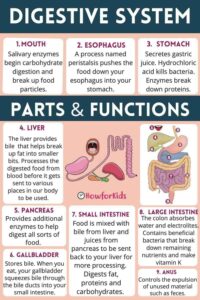
Digestive System: Organs and Functions
Table of Contents
The digestive system’s function is to transform food into small elements called nutrients. Nutrients are tiny substances, absorbed and used in cells. In order for you to grow healthy and for your body to function properly, you must provide it with the right amounts and proportions of nutrients.
The functions of the digestive system are:
• Transport food through your body to all cells.
• Segregate digestive juices.
• Absorb nutrients from food.
• Eliminate waste, which are substances that are no longer going to be used in our body.
PDF Free Printable
The Digestive System Printable Page
Explore the PDF pages on this website to find more resources for your students.
The Digestive System: How it Works.
In ancient times, scientists studied the human body as a machine. But over time they discovered that it was impossible to compare living beings with machines. For this reason, the organism is analyzed as a set of interrelated structures. In this system that is our body, the relationships established between these parts are as important as the parts themselves.
Human Digestive System and Nutrition Systems
We generally associate nutrition with everything we eat. The digestive system integrates one of the four 4 systems of nutrition. They reveal that we are not only nourished when we eat.
1. Digestive System.
4. Excretory Systems.
As the blood circulates through our body we are also nourished. The circulatory system through the blood, transports nutrients and oxygen, distributing them throughout the body for use. Breathing is involved in the oxygenation of all tissues and cells. What the body is no longer going to use is discarded through the excretory system.
How the Digestive System Works: Summary for Kids
The digestive system incorporates food by transforming it during the digestion process. This is not just breaking the food down, it breaks down the food into particles with a simpler chemical structure. This allows the small molecules to enter the bloodstream where the circulatory system will help distribute them throughout the cells.
Read Also: Food Groups for Children
What Organs make up the Digestive System?
What are the Functions of the Organs of the Digestive System?
The organs of the digestive system share the same goal: to transform food so that it can be absorbed. This system is made up of the mouth, esophagus, stomach, small intestine, the nutrients pass through its walls, they pass into the blood that will transport them to all the cells. What is not absorbed in the small intestine passes into the large intestine and exits through the anus as fecal matter.
Associated Glands: Functions
The digestive system has accessory organs and attached glands: the salivary glands, liver, gallbladder and pancreas. During digestion, food passes through the organs of the digestive tract, except for the accessory glands. Although food does not “circulate” through the glands and accessory organs. They produce juices and secretions that flow into the small intestine through ducts, and are involved in digestion.
The Digestive Process (Parts, Organs, and Functions)
Mouth
The mouth is a cavity where the teeth and the tongue are housed, through which food and drinks enter.
The teeth are responsible for chewing, whose purpose is to grind food. We must always keep them healthy, since they transform food so that it passes through the pharynx and the esophagus to the stomach. Teeth are not all the same and have different functions. The canines tear, the incisors cut, the molars and premolars grind and grind food.

The tongue is a muscle with a large number of taste buds, it contributes to chewing and mixing food, facilitating its transit to the esophagus. The salivary glands participate in chewing.
Saliva acts as a lubricant. It is composed of 95% water and 5% minerals such as sodium, potassium, chloride, bicarbonate and phosphates.
Function: In the mouth, the chemical digestion of carbohydrates begins by the action of the enzyme called amylase or ptyalin. It breaks down starch molecules into a simpler compound, called maltose. From chewing, a homogeneous mass is obtained: the food bolus that will pass into the pharynx.
Pharynx
In back of the mouth is the pharynx. It is part of both the digestive and respiratory systems. It is shaped like a tube. It is located in the neck and connects the nose and mouth with the trachea and the esophagus respectively. Both air and food pass through it by means of a “lid”. The epiglottis allows the food bolus not to go into the respiratory tract. The epiglottis closes when you swallow food.
Esophagus
It is a 25 to 30 cm tube that connects the pharynx with the stomach. Its function is to drive food from the pharynx to the stomach.
Stomach
It is an organ in the form of an elongated bag whose size can vary depending on the volume of its content. It has several parts:
The Stomach Anatomy: Parts and Functions
• Cardia: It is the opening (esophageal sphincter) that communicates with the esophagus, through which food enters.
• Fundus (bottom): It is located next to the cardia. It has cells that produce acid and pepsin (digestive enzyme) from gastric juice that help digest food.
• Body: It is the middle part, between the upper and lower part of the stomach.
• Antrum: It is the lower part, close to the intestine, where food is mixed with gastric juice.
• Pylorus: It is the outlet opening that leads to the intestine. It acts as a valve to control the emptying of stomach contents into the small intestine.
Function: The stomach receives the food bolus. It produces gastric juices that contain digestive enzymes. It makes some movements that beat the food and mix it with the gastric juices.
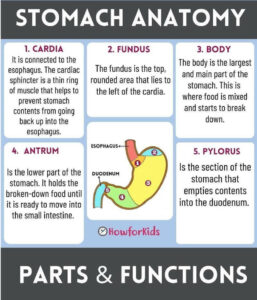
Intestine
The human intestine measures between 3 and 8 meters, depending on individual characteristics. The main function of the intestine is the incorporation of nutrients into the body. It is carried out through the processes of digestion and absorption of nutrients. The intestinal epithelium, which is the layer of cells that covers its interior, has multiple folds, which extend into intestinal villi and micro-villi, increasing the absorption surface up to 200 meters (656 feet). They are like tiny “hairs” on a towel. This is where nutrients from food are absorbed.
Small Intestine
It is a very long and folded tube that secretes digestive juices. This is where the usable substances pass into the blood. It is divided into three parts: Duodenum, jejunum, and ileum.
Large Intestine
It is the way out of substances that will not be assimilated called waste. It is formed by: cecum, colon, rectum and anus.
Liver
The liver is the largest gland in the body. The function of the liver is to make bile that is stored in the gallbladder. The bile is poured into the digestive tract in the duodenum. Contributes to the digestion of fats.
Pancreas
The pancreas is a gland that has the function of secreting the hormone insulin. Insulin controls the amount of sugar circulating in the blood and a lack of this hormone can cause a disease called diabetes mellitus.
What Is Digestion?
A food is incorporated into the body after being digested, that is, physically and chemically degraded so that its components can be absorbed, can pass through the wall of the digestive system and pass into the blood (or lymph).
To do this, food must undergo various physical and chemical changes that are called digestion and that make them “absorbable”.
Although it is not always necessary for some change to occur for the component to be absorbed. For example, water, minerals, and certain carbohydrates are absorbed without prior modification.
Digestion consists of two processes, one mechanical and one chemical. The mechanical part of digestion includes chewing, swallowing, peristalsis and elimination of waste.
Digestive Process for Kids
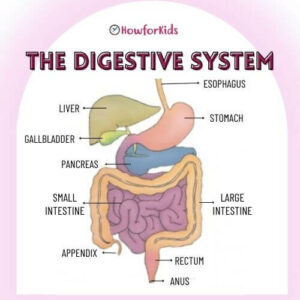
Digestion is not just a mechanical process in which food is crushed, cut and reduced to small particles by the action of the teeth and the tongue in the mouth. But there are also chemical transformations by the action of digestive juices on food.
Where does my food go after I eat it?
Here’s what happens to your food as it travels through your body.
It goes to cells throughout the body, which are constantly being replaced. Food is transformed during the digestion process until nutrients and energy are obtained. Human beings obtain the energy contained in food to carry out daily activities.
Read also: Human Body
Summary: What is Digestion?
Digestion is a process whose function is to transform food so that it can be absorbed and used by the cells of our body.
Where Does Food Go When You Eat?
It starts in the mouth, when you eat some food. The teeth cut and grind the largest pieces. Chewing is a very important step for the correct digestive process. We must chew by grinding the food well, slowly, to form the food bolus, which is a soft mass ready to be swallowed.
It goes down your throat through the tube formed by the larynx and esophagus and from then on you are not really aware of what is happening. It then continues to the stomach, small intestine, large intestine. The material that is not used is compacted in the form of fecal matter and eliminated to the outside through the anus.
Some organs of the digestive system have the function of producing digestive juices. On the sides of the alimentary canal are accessory organs (called accessory glands). Its function is to secrete more juices that are poured into the tube to help digestion. These accessory glands are the salivary glands, liver, and pancreas.
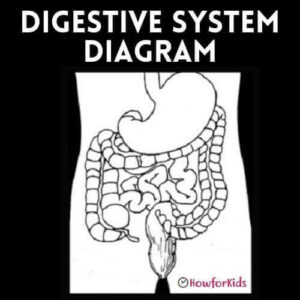
Digestive System: Conditions and Disorders
What are some common conditions that affect the digestive system?
There are many diseases that can affect the different organs of the digestive system. We are going to mention a few.
• Celiac Disease: It is a disease in which affected people do not tolerate a protein called gluten. They should not eat any food that has gluten. Because if they do they suffer from diarrhoea, intestinal inflammation, lack of growth. Gluten is found in foods with wheat, rye, barley, and sometimes oats. They must check that all the products they consume have the symbol suitable for celiacs on the labels. Diarrhea: It can occur when you consume contaminated water or lack of hygiene during food handling. Causes liquid, frequent stools, abdominal pain, fever.
• Constipation: it is the difficulty in the evacuation with delay in the elimination of intestinal waste. It can cause abdominal pain, swelling, others.
• Caries: Damage to the tooth enamel caused by bacteria.
• Gastric ulcers: They are open or unhealed wounds that in this case are located in the stomach.
• Gastritis: It is inflammation of the stomach.
• Hepatitis: Inflammation of the liver.
• Appendicitis: Inflammation of the appendix
• Inflammatory bowel diseases (IBD): Crohn’s disease, ulcerative colitis.
• Diverticulosis: Disorder in the intestine.
• Achalasia: Disease in the esophagus. Difficulty to swallow.

